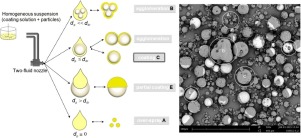Particle coatings are used extensively to generate dispersed solids with well-defined properties, e.g., to protect active ingredients, with most coating processes using core particles of a diameter larger than 200 μm. This work contributes to the development of a coating process for fine dispersed particles (diameter less than 50 μm) by combining two particle-formulation processes, namely, coating and spray drying. The feasibility of the operation is based on and demonstrated by the innovative application of a two-fluid nozzle. Experiments were conducted by using glass particles as core particles and sodium benzoate as the coating agent. The coating of finely dispersed particles is achieved by the spraying of particles and coating solution as a homogeneous suspension. The aim is to create droplets with only one contained particle at the nozzle outlet. After evaporation of the water in the droplet, a thin solid film is built on the particle surface. The suspension viscosity was measured and compared with empirical equations from the literature. The liquid-film thickness on the particle surface was calculated to predict the building of a uniform coating layer or agglomerates. In this study, the feasibility of pneumatic transport through the nozzle and an investigation of the process were illustrated. The agglomeration fraction and degree of coating of the particle surface were analyzed optically by scanning electron microscopy. In this way, the influence of different processes and suspension parameters on the product quality were determined.
- Home
- Blog
- News
- Basics
- Sources
- Agencies, Regulatory & Organisations
- CERSI Excipients Browser
- Excipient Report
- Excipient DMF List
- EXCiPACT Certified Companies
- Excipient Documentation
- Excipient EINECS Numbers
- Excipient E-Numbers
- FDA Inactive Ingredient List
- FDA GRAS Substances (SCOGS) Database
- IPEC Americas
- USP - U.S. Pharmacopeia
- Definitions
- Whitepapers / Publications
- Supplier
- Services
- Media
- Events
- 1st pharmaexcipients Poster Award
- Event Calendar
- Events featured by pharma-excipients
- 4th Annual Formulation & Drug Delivery Congress
- DDF Summit
- ExcipientFest Americas
- ExcipientFest Asia
- Global CompliancePanel
- International Conference and Exhibition on Pharmaceutics & Novel Drug Delivery Systems
- Formulation & Drug Delivery USA Congress
- Laboratory Medicine 2018
- Making Pharmaceuticals Europe
- Making Pharmaceuticals Exhibition
- Pharma Integrates
- PharmaExcipients China @CPhI China
- TTC Technology Training Center
- Jobs
- Online Sourcing
- Contact

